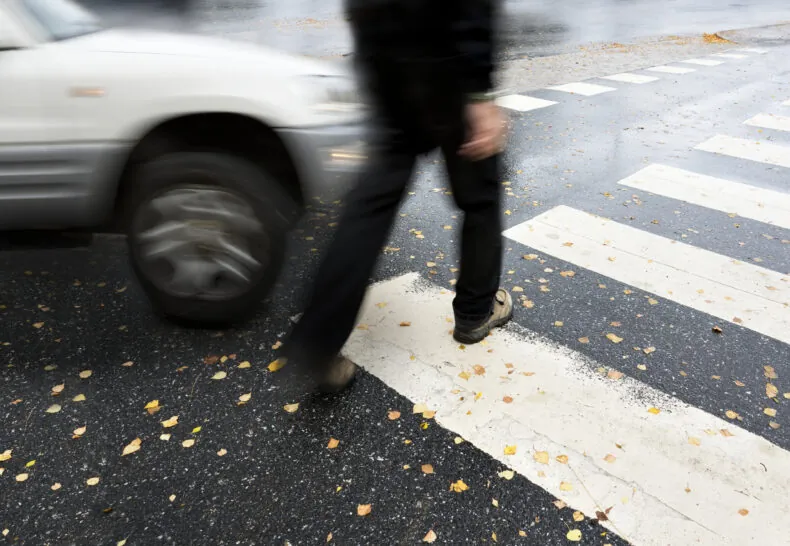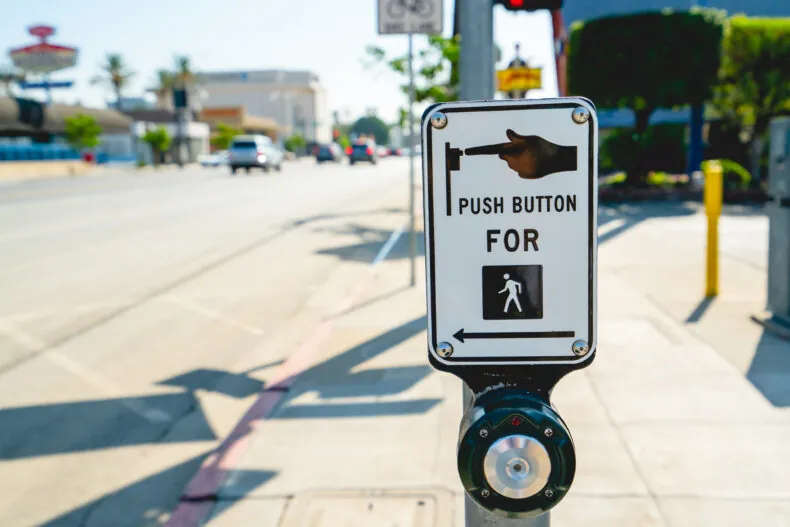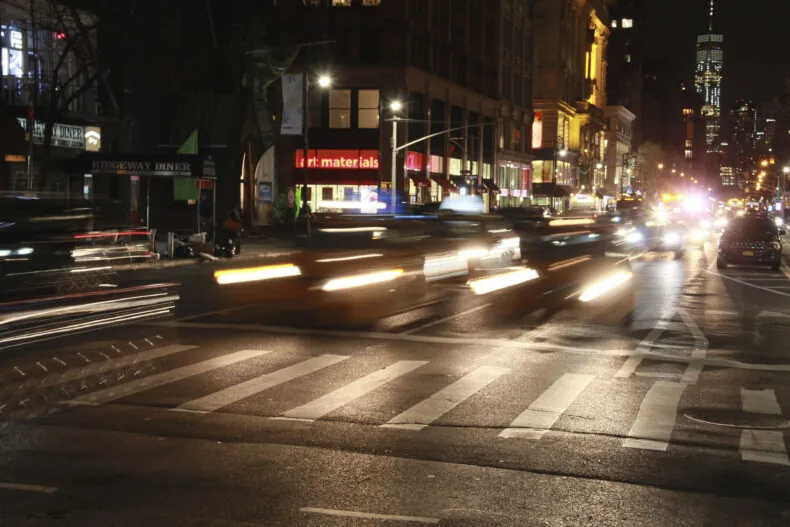Who is Considered a Pedestrian in California?
California is one of the most popular travel destinations in the United States and sees over 275 million visitors each year. Los Angeles alone welcomed 46.2 million visitors. Popular attractions in California include Disneyland Park, Universal Studios Hollywood, the Golden Gate Bridge, Santa Monica Pier, and Yosemite National Park.
Whether strolling along bustling city streets or enjoying leisurely walks in parks or beaches, California’s warm weather, attractions, and beautiful landscapes encourage people to travel by foot. Not everyone may be aware of who exactly is considered a pedestrian in California.
What is a Pedestrian Under California Law?
In California, the term “pedestrian” is defined as any person who is traveling on foot or using human-powered devices, such as:
- Scooters
- Roller skates
- Skateboards
- Tricycles
- Quadricycles
- Wheelchairs
Essentially, anyone who is not operating a motorized vehicle qualifies as a pedestrian. This broad definition includes people walking, jogging, running, using mobility aids like wheelchairs, and those who use non-motorized vehicles.
Pedestrian Laws in California
Under California Vehicle Code 21949, drivers must exercise extreme caution around pedestrians. When approaching a marked or unmarked crosswalk, drivers are required by law to yield the right-of-way to pedestrians. However, this does not relieve a pedestrian from exercising care for their safety. For example, pedestrians are not permitted to suddenly leave a curb and bolt across the street. Consequently, if a pedestrian crosses the road suddenly in front of an oncoming vehicle, causing an accident, they may be held liable.
Additionally, CVC Section 21950 states that pedestrians must use designated crosswalks when available and follow traffic signals at intersections. Crossing a street outside of a marked crosswalk, especially if there is a signal indicating pedestrians should not cross, is considered jaywalking.
Pedestrian Responsibilities for Safety
While drivers have a significant responsibility to prioritize pedestrian safety, pedestrians also must be attentive and aware of their surroundings.
- Pedestrians must remain vigilant when crossing the street, looking both ways before stepping into traffic.
- Pedestrians should use designated crosswalks and obey traffic signals which can significantly reduce the risk of pedestrian accidents.
- Additionally, pedestrians should avoid distractions, such as texting or listening to loud music while walking.
Those Who Are Not Considered Pedestrians
There are specific scenarios in which individuals may not be considered pedestrians under California law. For example, individuals operating motorized vehicles, such as cars, trucks, motorcycles, bicycles, electric bicycles, or motorized scooters are not classified as pedestrians. Instead, they are considered drivers and must abide by a distinct set of traffic rules and regulations.
Do Pedestrians Always Have the Right-of-Way in California?
According to California pedestrian laws, pedestrians have the right-of-way at marked or unmarked crosswalks, and drivers must yield to them. However, this does not mean that pedestrians always have the right-of-way in every situation.
Pedestrians must exercise caution and use designated crosswalks to avoid accidents. If a pedestrian suddenly crosses the street, drivers may not be able to stop in time. Pedestrians can be cited for jaywalking if there is an “immediate danger of collision” with a moving vehicle or a device moving exclusively by human power.
Why So Many Pedestrian Accidents Happen
Despite efforts to protect pedestrians through traffic laws and safety campaigns, pedestrian accidents remain a significant concern in California. Some factors that commonly cause pedestrian accidents include the following:
- Distracted driving and walking
- Alcohol-impaired driving and walking
- Recklessness
- Speeding
- Failure to yield
- Road construction
- Poor lighting
- Poor road design
California Pedestrian Accident Statistics
According to the California Office of Traffic Safety (OTS), pedestrian fatalities increased 9.4% from 1,013 in 2020 to 1,108 in 2021. Pedestrian deaths account for 17% of all traffic fatalities. The majority of pedestrian accidents occur in urban areas. In 2022, California’s pedestrian fatality rate was 1.29 deaths per 100,000 people. This is substantially higher than the national rate of 1.04.
Understanding these statistics can serve as a wake-up call for both policymakers and individuals to prioritize pedestrian safety and work towards reducing the number of accidents on California’s roads.
What to Do After a Pedestrian Accident
1. Ensure Safety and Seek Medical Attention
Check yourself and others for injuries and call for emergency medical assistance. It’s crucial to seek medical attention immediately after a pedestrian accident.
2. Contact the Police
Call 911 and ensure you obtain a police report. Cooperate with law enforcement and provide accurate details about the accident to the best of your ability.
3. Gather Information
Collect vital information from the accident scene. This includes the names, contact details, driver’s licenses, and insurance information of all parties involved. Additionally, take photos of the accident scene, vehicle positions, broken glass, skid marks, road conditions, and any visible injuries sustained.
4. Get a Medical Evaluation
Even if you believe your injuries are minor, it is essential to seek medical evaluation promptly. Some injuries may not be immediately apparent, and a medical professional can identify and document them properly. This medical record will be crucial when dealing with insurance companies and can strengthen your personal injury claim.
5. Document Your Expenses and Losses
Keep detailed records of all expenses related to the accident, including medical bills, prescriptions, transportation costs, and any other out-of-pocket expenses. Also, document any lost wages or income due to injuries that prevented you from working.
6. Stay Cautious on Social Media
Refrain from discussing the accident or your injuries on social media platforms. Insurance adjusters and opposing parties may use your posts against you, so it’s best to avoid sharing such information publicly.
7. Don’t Deal With the Insurance Company Alone
If an insurance company or the at-fault party approaches you with a settlement offer, be cautious about accepting it without consulting a pedestrian accident lawyer. Often, initial settlement offers are lower than what you may be entitled to, and an experienced personal injury attorney can help you negotiate fair compensation.
8. Consult an Experienced Pedestrian Accident Lawyer
If you were involved in a pedestrian accident, consider securing legal counsel. A pedestrian accident attorney can help you understand your rights, guide you through the entire legal process, help you prove liability, and assist in obtaining fair compensation for your injuries and damages.
Contact an Experienced California Pedestrian Accident Lawyer
Understanding who is considered a pedestrian under California law is vital for both pedestrians and drivers to ensure safety on the state’s roadways. If you are an injured pedestrian or the loved one of a pedestrian accident victim, it’s vital to seek medical attention immediately and consult with an experienced California pedestrian accident lawyer.
At Alpha Accident Lawyers, we are committed to helping injured victims recover compensation for their serious injuries and losses. Our award-winning law firm has years of experience representing pedestrian accident victims. Call our Los Angeles personal injury law office today to schedule a free consultation.
START YOUR FREE CONSULTATION




![Renee Gonzalez Killed in Pedestrian Accident on Highway 199 [Springtown, TX]](https://alphaaccidentlawyers.com/wp-content/uploads/2023/11/iStock-1472245535-1-720x480.jpg.webp)

